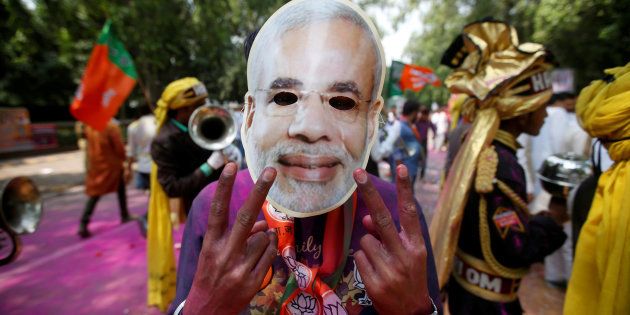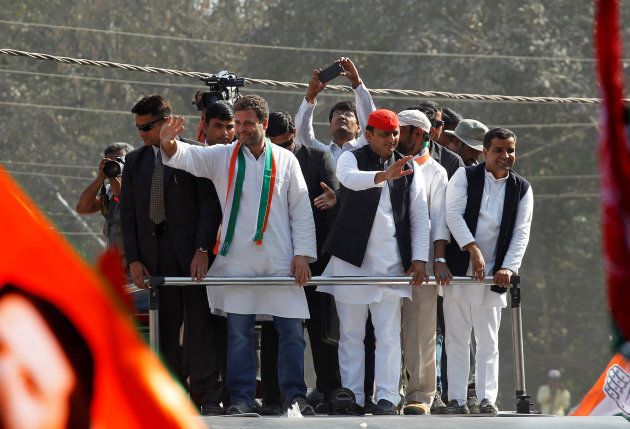
It is in the nature of instant media analysis that one tends to miss the woods for the trees. The results of the elections to five state legislatures in India–Uttar Pradesh, Uttarakhand, Punjab, Goa and Manipur—reinforce an underlying power shift in Indian politics that has been visible for at least eight years. The Indian National Congress–more correctly the 'Sonia Congress'—is in a secular decline and the Bharatiya Janata Party—more accurately Modi's BJP—is in a long-term rising curve.
With the singular exception of Punjab, the BJP has garnered the largest vote share in each of the other four states. The Punjab result does not indicate that the tide has turned for the Sonia Congress. It merely shows that Amarinder Singh was the most preferred chief minister candidate, that both the Akali Dal and the BJP transferred at least some of their votes to the Congress, preferring an Amarinder government to an Arvind Kejriwal government and that the challenge posed by AAP was in fact highly exaggerated, mostly by the media!
The Bharatiya Janata Party—more accurately Modi's BJP—is in a long-term rising curve.
Winning in Manipur or Goa (an outcome that is still in doubt as this column is being written) is no compensation for the Congress. The fact is that the Congress Party has been in the throes of a leadership crisis and an internal loss of confidence ever since Rahul Gandhi was named its future leader. He has not been able to inspire the confidence of his own party, leave alone the average voter.
In U.P., Rahul's decision to hop on to Akhilesh Yadav's bicycle was viewed as a clever strategic move, even by seasoned political analysts. It was, in fact, a desperate attempt to remain relevant in the heartland of north Indian politics.

Narendra Modi was among the first to recognize this structural crisis within the Congress when he set himself the target of a "Congress-mukt Bharat" and secured an absolute majority for the BJP in 2014 Lok Sabha elections. However, while Modi judged Rahul Gandhi's worth correctly, not seeing in him a future challenger, he seemed to have acquired an exaggerated view of himself. His first year was full of mistakes—on almost all fronts, with the exception of his successful global image building. He paid a price for it in Delhi and Bihar. In Bihar he retrieved ground quickly by reaching out to Nitish Kumar. After all, Nitish was a former BJP ally. In Kejriwal, Modi discovered a tough customer. Like jack-in-the-box, Kejriwal kept popping up each time Modi thought he had put the lid on him. Modi needed a weapon to deal with Kejriwal. Demonetisation was that weapon.
While economists argued about the economic consequences of demonetization, Modi used that disruptive intervention to project himself as the real fighter against privilege, wealth and corruption. He successfully unseated Kejriwal from the high moral pedestal that he occupied with his India Against Corruption campaign.

In analyzing the battles that Modi has won and lost, one must not lose sight of the war that has been waged over the past quarter century. Beginning with Indira Gandhi's death in 1984, the Bharatiya Janata Party has sought to replace the Congress Party as the mainstream, natural party of government. The Uttar Pradesh result confirms a trend first established by the 2014 result.
All this is not to suggest that the Congress has no future. It is still a national party and even in 2014, when it faced its most ignominious defeat, it secured close to 20 per cent of the national vote. The Congress has pockets of influence and it has the capacity to repeat the Punjab result in a couple of BJP-ruled states, especially Rajasthan. Vasundhara Scindia's government has become unpopular and can easily be defeated if the Congress can find an Amarinder Singh in Rajasthan. It is not Rahul Gandhi who can get Congress back to power in Rajasthan, but one of the state-level leaders. It remains to be seen which of them has the political energy needed to grab power.
While every political party has its ups and downs, and the so-called 'anti-incumbency' factor in Indian elections always gives hopes to parties that are out of political office, one must come to terms with the big picture of the longer term power shift in India—the decline of the Congress and the rise of the BJP. The March 11th results will constitute an important milestone in that power shift.
Also On HuffPost:
